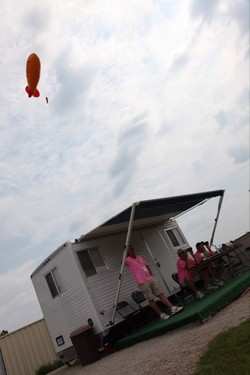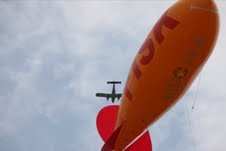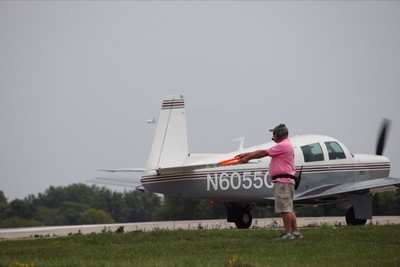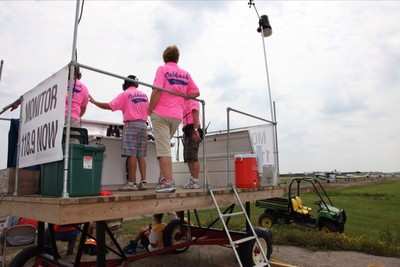A Visit To The Control Tower Cab, Fisk, And A MOOCOW
By Robbie Culver
Before arriving aircraft at Oshkosh become the responsibility of
the Wittman Regional Airport control tower, they are handled
through the Fisk approach controllers, then handed off to one of
the two control tower frequencies depending on the runway
assignment for the aircraft. Fisk is where the tour of
the air traffic system for AirVenture continued.

Facility at Fisk
Each tower then brings the arriving aircraft into the
pattern as required to fit traffic,and handles them until they land
and clear the runway. There is no ground control at Oshkosh - the
entire movement area is controlled by ground staff managing the
flow around the airport.
Located in the sleepy town of Fisk, Wisconsin, on a small hill
overlooking the approach corridor from Ripon, Fisk Approach is
quiet and beautiful. For years, Fisk approach has been the domain
of Ray Thyfault. Based at the Kalamazoo, Michigan airport when he
is not working Airventure, Thyfault is referred to as a "walking
encyclopedia" of aircraft, often able to spot and identify an
aircraft well ahead of his peers. Accordingly, Fisk is referred to
as "RAYCON" - short for Ray Control, a takeoff on TRACON and an
inside joke for the controllers working Fisk. Adelman told the
media representatives that when it comes to Fisk, "whatever Ray
wants, he gets."
The saying with air traffic control is that as Fisk goes, so
goes Oshkosh. Adelman stated emphatically that when Thyfault works
his magic at Fisk, he makes the entire event go smoothly. One
change implemented this year was the removal of the strobe light on
the railroad tracks, and the addition of a large yellow balloon on
a 100 foot high tether. When asked, Thyfault stated this was due to
the strobe light being located in a location that brought the
arriving aircraft slightly off course. He also revealed that the
GPS waypoint FISKE is actually more than a mile off target. The FAA
is working to resolve this.

Fisk Baloon
Fisk's assignment is to deal with aircraft arriving at
different altitudes and airspeeds, sort them out, assign them a
frequency and a direction to fly, then hand them off to the tower.
Two ongoing challenges are the differing airspeeds and altitudes,
and aircraft misinterpreting instructions meant for another
aircraft. Since the communication at Fisk is one-way, controller to
pilot, it is up to the controller to convince the pilot of their
errant ways and bring them back on course. Typically, the only
feedback a controller receives is when they request an inbound
aircraft to rock their wings to acknowledge their instructions. At
Fisk, silence is golden.
The banter between the controllers was more evident, as only one
team works Fisk, instead of the two in the tower. But that banter
was offset by the professionalism and attention to detail that the
controllers exhibit. Traffic was flowing in at a steady rate, and
the tower called and requested a hold on inbound arrivals to allow
for some departures. So, the controllers instituted the Green Lake
holding pattern, and the aircraft above us began to orbit the
lake.
And that's when the fun began overhead - while Theyfault was
discussing operational procedures with us, he glanced up and noted
a single engine Cessna approaching Fisk from the northwest - the
wrong direction - at a 90 degree angle to the inbound arrivals, and
behind the controllers working inbound traffic. Theyfault glanced
back at the arrival flow, at the interloper, and quickly determined
there was no conflict. The offender did not contact Fisk and was
gone as fast as they arrived. Another morning at Fisk.
Departures are handled in a manner unique to Oshkosh, called
look and go. In other words, they use their Mark I eyeball to
determine when its safe to let a departure go. This requires the
controllers in what are called "MOOCOWs" (Mobile Operations and
Communications Workstations - we are in Wisconsin, after all)
located adjacent to the departure end of the runway to visually
clear the airspace required to fit the departure in, then wave
frantically at the pilot to get them the heck off their runway
before the next arrival literally seconds later. It's crazy to see
in practice, but it works well.

Oshkosh 'Ground Control'
The MOOCOW was the final stop on our tour. Originally, we were
to visit the MOOCOW after the tower, but a groundloop incident
prompted a change in plans.
The taxiway was buzzing as aircraft lined up waiting to depart,
and runway 36 was steadily receiving inbound aircraft, the Ford
TriMotor, and a Breezy hopping rides. Three controllers worked from
a platform adjacent to the taxiway, while one stood out at the
runway and taxiway intersection directing aircraft with orange
batons and the radio as required. The look and go operations were
educational and entertaining to watch, as the controller at the
runway would watch carefully, then emphatically urge the waiting
aircraft to depart. Sometimes a bit more emphasis was required, and
the controllers seemed to have no problem being creative as to how
to get someone's attention.
MOOCOW's are operationally unique to Oshkosh, as is look and go,
but the controllers at the spring airshow at Lakeland (referred to
as "Oshkosh Lite" by Airventure veterans) have now implemented the
MOOCOW with a more southern flair, calling it the GATOR.

Oshkosh MOOCOW
As we left the MOOCOW and the frantic activity at the runway's
edge, I could not help but note that everyone involved seemed to be
genuinely enjoying their work. Airventure is a huge team effort,
but perhaps no one part of the Airventure experience is as critical
as the fantastic team of Air Traffic Controllers assigned to the
event.
 ANN's Daily Aero-Linx (04.15.24)
ANN's Daily Aero-Linx (04.15.24) Classic Aero-TV: 'No Other Options' -- The Israeli Air Force's Danny Shapira
Classic Aero-TV: 'No Other Options' -- The Israeli Air Force's Danny Shapira Aero-News: Quote of the Day (04.15.24)
Aero-News: Quote of the Day (04.15.24) Airborne 04.16.24: RV Update, Affordable Flying Expo, Diamond Lil
Airborne 04.16.24: RV Update, Affordable Flying Expo, Diamond Lil ANN's Daily Aero-Term (04.16.24): Chart Supplement US
ANN's Daily Aero-Term (04.16.24): Chart Supplement US






